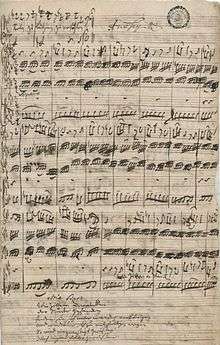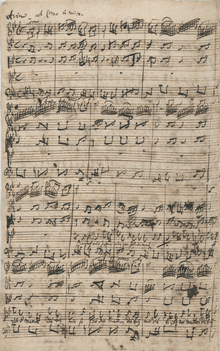''Herr, gehe nicht ins Gericht mit deinem Knecht'', BWV 105

Herr, gehe nicht ins Gericht mit deinem Knecht (Lord, do not pass judgment on Your servant), BWV 105 is a church cantata by Johann Sebastian Bach. He composed it in Leipzig for the ninth Sunday after Trinity and first performed it on 25 July 1723.
History and text
Bach composed the cantata in his first year in Leipzig for the Ninth Sunday after Trinity. The prescribed readings for the Sunday were from the Epistle to the Romans, a warning of false gods and consolation in temptation (1 Corinthians 10:6–13), and from the Gospel of Luke, the parable of the Unjust Steward (Luke 16:1–9). The opening lines of the cantata, by an unknown librettist, come from Psalm 143. The theme of the cantata is derived from the Gospel: since mankind cannot survive before God's judgement, he should forswear earthly pleasures, the mammon of unrighteousness, for the friendship of Jesus alone; for by His death mankind's guilt was absolved, opening up the everlasting habitations. The closing chorale is the eleventh verse of the hymn Jesu, der du meine Seele, written by Johann Rist in 1641.
Bach first performed the cantata on 25 July 1723.
Scoring and structure
The cantata in six movements is scored for four vocal soloists (soprano, alto, tenor and bass), a four-part choir, corno, two oboes, two violins, viola, and basso continuo.[1]
- Chorus: Herr, gehe nicht ins Gericht mit deinem Knecht (Lord, enter not into judgment with thy servant)
- Recitative (alto): Mein Gott, verwirf mich nicht (My God, cast me not away)
- Aria (soprano): Wie zittern und wanken der Sünder Gedanken (How they quiver and waver, the thoughts of sinners)
- Recitative (bass): Wohl aber dem, der seinen Bürgen weiß (Happy is he who knows his protector)
- Aria (tenor): Kann ich nur Jesum mir zum Freunde machen (If I can but make Jesus my friend)
- Chorale: Nun, ich weiß, du wirst mir stillen, mein Gewissen, das mich plagt (Now I know that Thou will calm my conscience that torments me.)
Characteristics

The cantata opens with a sombre harmonically complex orchestral prelude (adagio), with tortured chromatic modulations, suspended sevenths and a sighing, mournful motif in the violins and oboes. Similar chromaticism has been used elsewhere by Bach[2] to illustrate the crucifixion, for example for the Crucifixus section of the Credo in the Mass in B minor[3] and for the last stanza, "trug uns'rer Sünden schwere Bürd' wohl an dem Kreuze lange", in the choral prelude O Mensch, bewein dein Sünde groß, BWV 622.[4] The chorus enters independently in polyphonic motet style over this rich orchestral texture. This is followed by a measured permutation fugue (allegro), initially for only the concertante singers and continuo, but eventually taken up by the whole ripieno choir, doubled by the orchestra.
The short but expressive alto recitative is followed by one of Bach's most original and striking arias, depicting in musical terms the anxiety and restless desperation of the sinner. Over a background of repeated tremolo notes in the upper strings (without continuo), the obbligato oboe and then the soprano interweave two highly ornate but tortuous melodic lines, their melismas and disturbing dissonances representing the troubled soul.
The mood becomes hopeful in the following accompanied bass recitative, leading to the ecstatic and animated concerto-like aria for tenor, corno and strings, with rapid passagework for the first violins.
The tremolo string motif returns in the final chorale. With each successive stanza, the tremolo gradually becomes less rapid, echoing the calming of man after conciliation with his Maker and bringing to an end a cantata that the musicologist Alfred Dürr has described as one of "the most sublime descriptions of the soul in baroque and Christian art".[5]
Transcriptions
- Albrecht Mayer (oboe), The English Concert, Trinity Baroque, Concerto for Oboe and Strings (BWV 105/v, 170/i and 49/i), Decca, 2010.
Selected recordings
- Les Grandes Cantates de J.S. Bach Vol. 16, Fritz Werner, Heinrich-Schütz-Chor Heilbronn, Pforzheim Chamber Orchestra, Agnes Giebel, Claudia Hellmann, Helmut Krebs, Erich Wenk, Erato 1963
- J. S. Bach Kantaten: BWV 73, 105 and 131, Philippe Herreweghe, Collegium Vocale, Barbara Schlick, Gérard Lesne, Howard Crook, Peter Kooy, Virgin Records 1990
- J. S. Bach: Complete Cantatas Vol. 7, Ton Koopman, Amsterdam Baroque Orchestra & Choir, Lisa Larsson, Elisabeth von Magnus, Gerd Türk, Klaus Mertens, Antoine Marchand 1997
- J. S. Bach: The Sacred Cantatas, Vol. 10, Masaaki Suzuki, Bach Collegium Japan, Miah Persson, Robin Blaze, Makoto Sakurada, Peter Kooij, BIS
References
- ↑ BWV 105, University of Alberta
- ↑ Chafe 2003, p. 28. According to the iconography of the Lutheran canon, chromaticism symbolized Christus Coronobit Crucigeros.
- ↑ Butt 1991, p. 85
- ↑ Williams 1980, pp. 61–62
- ↑ Dürr 2006, pp. 464–467
Cited sources
- Butt, John (1991), Bach: Mass in B minor, Cambridge University Press, ISBN 0-521-38716-7
- Chafe, Eric (2003), Analyzing Bach Cantatas, Oxford University Press, ISBN 0-19-516182-3
- Alfred Dürr (2006), The cantatas of J.S. Bach, Oxford University Press, ISBN 0-19-929776-2
- Williams, Peter (1980), The Organ Music of J.S. Bach, Vol. II, Cambridge University Press, ISBN 0-521-31700-2
Further reading
- Marshall, Robert L. (1989), The Music of Johann Sebastian Bach: the Sources, the Style, the Significance, Schirmer Books, pp. 131–142, ISBN 978-0-02-871782-1 This essay analyses Bach's compositional methods by examining alterations in the autograph manuscript of BWV 105.
External links
- Herr, gehe nicht ins Gericht, BWV 105: Scores at the International Music Score Library Project (IMSLP)
- Herr, gehe nicht ins Gericht BWV 105; BC A 114 / Sacred cantata (9th Sunday after Trinity) Bach Digital
- Cantata BWV 105 Herr, gehe nicht ins Gericht mit deinem Knecht history, scoring, sources for text and music, translations to various languages, discography, discussion, bach-cantatas website
- BWV 105 – "Herr, gehe nicht ins Gericht mit deinem Knecht" English translation, discussion, Emmanuel Music
- BWV 105 Herr, gehe nicht ins Gericht mit deinem Knecht English translation, University of Vermont
- Chapter 11 BWV 105 Herr, gehe nicht ins Gericht mit deinem Knecht / Lord, do not enter into judgement with Your servant. Julian Mincham, 2010